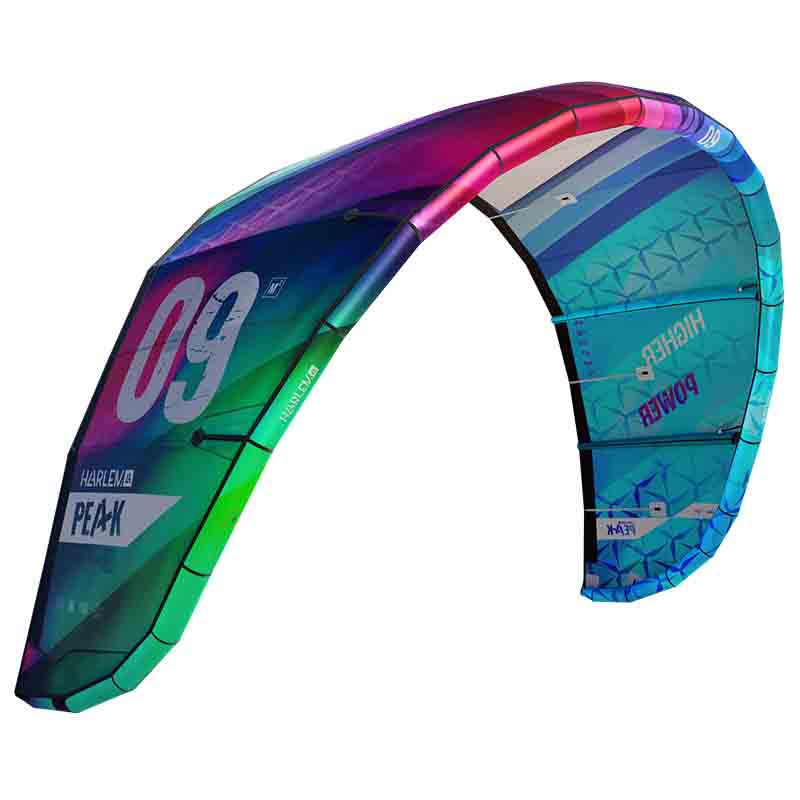When you purchase gear through links on our site, we may earn a small commission. Here’s why you can trust our tests and our affiliate partner.

Over the past few months, we’ve caught glimpses of the Harlem Peak prototype countless times, both in person and across social media. Now, Harlem has finally launched it to the public, and we’ve been lucky enough to get our hands on several sizes to put the full range to the test.
The Peak follows in the footsteps of Harlem’s recent successes, the Force and the Thrive. Designed by Ralf Groesel and developed and tested extensively by Hadlow and Casati, its development team alone hints at the high performance we were about to experience, and it didn’t disappoint!
Our first impression as we pulled the Peak out of its colorful bag was just how light it felt, noticeably lighter than other kites of the same size and category. The Peak is a 5-strut kite, but it’s built using materials and techniques that set it apart from industry standards. The canopy is made from Twincross Flylite, a distinct material that feels (and even sounds) different from traditional fabrics. It’s noticeably lighter and also allows for digital printing, so spotting this kite in the sky is never a problem. On the leading edge, Harlem uses Proweld technology, which welds panels together instead of stitching them. This not only cuts weight but also increases stiffness in the airframe. Another standout feature is the use of laminated Mylar for the struts, which again helps reduce weight while improving rigidity. Despite all these lightweight innovations, Harlem hasn’t skimped on reinforcements, ensuring durability without compromise and having impressive attention to detail. While setting up, one small but interesting feature caught our eye: each segment of the leading edge had a bridle attachment point right at the joint! But enough with the technical talk, let’s get into the fun part.
We may have slightly misjudged the wind strength for our first session – while everyone else was comfortably riding 6-7m kites, we stubbornly stuck with the 9m Peak. But hey, what better way to test its high-end performance? (And let’s be honest, it was the perfect excuse not to trek back to the car for a smaller size.) Once we had the Peak in the air, it immediately felt familiar: light bar pressure with excellent feedback and responsiveness. Just a few tacks in, we noticed something special: the Peak’s wind-window positioning delivers remarkable upwind ability. Even more impressive was its massive depower – even in the strongest gusts, it remained precise and stable, never yanking us off the water. It left us convinced that in smaller sizes, this kite’s high-end performance is virtually endless. Overpowered? Yes. Out of control? Never.
Now, let’s talk about what really matters: airtime. This kite is built for it and Harlem absolutely nailed it. The standout feature? Explosive vertical lift, the kind that surprises you with every takeoff. We call it the “elevator effect” – that rare, addictive sensation of being shot upward effortlessly. Hangtime is equally impressive, and the best part? You don’t need perfect technique, it’s easy to send, easy to time and delivers massive height and distance.
Kiteloops? As easy as they come. A hard yank on the bar and the kite whips into a tight, intuitive loop, often giving you a second boost mid-air, perfect for learning new tricks or pushing your limits. And for those craving power, the Peak delivers monster megaloops with minimal effort; just play with the bar input, and the kite rewards you with serious yank. Thanks to its floaty, forgiving nature and tendency to overfly, timing downloops (most of the times, multiples) and sticking landings felt almost too easy.
As we tested multiple sizes of the Harlem Peak, one thing became clear: this kite delivers consistent, high-level performance across the entire range, no matter the wind or size. Even on lighter days with the 12m, the Peak surprised us with impressive lift and hangtime, while remaining fast and responsive enough to catch us during kiteloops. What started as a casual cruising session quickly turned into an exhausting (but ridiculously fun) trick-fest, proof that this kite thrives on pushing limits.
So, is this kite just for the pros? Absolutely not. While it packs elite-level performance, the Peak remains shockingly accessible. Freeriders will love its “sheet-and-go” simplicity, fast handling and effortless jumping, all while delivering instant confidence through intuitive feedback. Yet, it’s the Big-Air specialists who’ll truly geek out over this kite. With its massive wind range, explosive lift, floaty hangtime and tight, snappy kiteloops, the Peak is a legitimate weapon for sending it to the moon. Bottom line? If you’re hunting for a do-it-all freeride kite that doubles as a Big-Air beast, the Harlem Peak deserves a spot at the top of your demo list.
